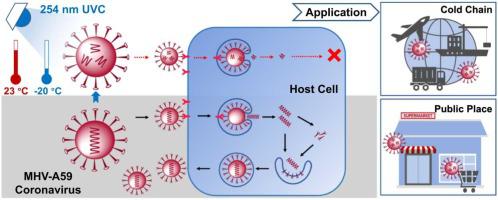Journal of Environmental Chemical Engineering ( IF 7.7 ) Pub Date : 2022-01-13 , DOI: 10.1016/j.jece.2022.107206 Min Li 1, 2 , Jiahuan Li 1, 2 , Yunlong Yang 3 , Wenhui Liu 3 , Zhihui Liang 1, 2 , Guanyu Ding 4 , Xiaohe Chen 5 , Qi Song 4, 5 , Changying Xue 3 , Bingbing Sun 1, 2

|
The surface contamination of SARS-CoV-2 is becoming a potential source of virus transmission during the pandemic of COVID-19. Under the cold environment, the infection incidents would be more severe with the increase of virus survival time. Thus, the disinfection of contaminated surfaces in both ambient and cold environments is a critical measure to restrain the spread of the virus. In our study, it was demonstrated that the 254 nm ultraviolet-C (UVC) is an efficient method to inactivate a coronavirus, mouse hepatitis virus strain A59 (MHV-A59). The inactivation rate to MHV-A59 coronavirus was up to 99.99% when UVC doses were 2.90 and 14.0 mJ/cm2 at room temperature (23 °C) and in cold environment (−20 °C), respectively. Further mechanistic study demonstrated that UVC could induce spike protein damage to partly impede virus attachment and genome penetration processes, which contributes to 12% loss of viral infectivity. Additionally, it can induce genome damage to significantly interrupt genome replication, protein synthesis, virus assembly and release processes, which takes up 88% contribution to viral inactivation. With these mechanistic understandings, it will greatly contribute to the prevention and control of the current SARS-CoV-2 transmissions in cold chains (low temperature-controlled product supply chains), public area such as airport, school, and warehouse.
中文翻译:

小鼠肝炎病毒株 A59 在环境和寒冷环境下的灭活研究揭示了 UVC 暴露后传染性降低的机制
SARS-CoV-2 的表面污染正在成为 COVID-19 大流行期间病毒传播的潜在来源。在寒冷环境下,随着病毒存活时间的增加,感染事件会更加严重。因此,在环境和寒冷环境中对受污染表面进行消毒是抑制病毒传播的关键措施。在我们的研究中,证明 254 nm 紫外线-C (UVC) 是灭活冠状病毒小鼠肝炎病毒株 A59 (MHV-A59) 的有效方法。当UVC剂量为2.90和14.0 mJ/cm 2时,对MHV-A59冠状病毒的灭活率高达99.99%分别在室温(23°C)和寒冷环境(-20°C)下。进一步的机理研究表明,UVC 可以诱导刺突蛋白损伤,部分阻碍病毒附着和基因组渗透过程,从而导致 12% 的病毒感染性丧失。此外,它可以诱导基因组损伤,从而显着中断基因组复制、蛋白质合成、病毒组装和释放过程,这些过程占病毒灭活的 88%。有了这些机制上的理解,它将极大地有助于预防和控制当前 SARS-CoV-2 在冷链(低温控制产品供应链)、机场、学校和仓库等公共区域的传播。



























 京公网安备 11010802027423号
京公网安备 11010802027423号